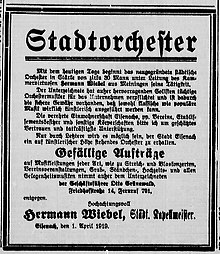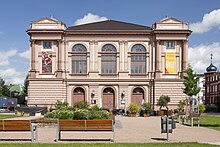City Orchestra Eisenach
The Stadtorchester Eisenach was a German theater and symphony orchestra based in Eisenach , which was upgraded to the Landeskapelle Eisenach in 1952 and became part of the Thuringia Philharmonic Gotha-Eisenach in 2017 . Committed to the musical tradition of the city of Eisenach, the orchestra devoted itself not only to the classical repertoire in operas, operettas and concerts, but also to maintaining older music and contemporary compositions.
history
In the royal seat of the Duchy of Saxony-Eisenach , a court orchestra was founded in 1672 for the musical organization of court ceremonies; its first director was Daniel Eberlin . From 1708 to 1712 Georg Philipp Telemann was concertmaster in Eisenach, he also directed the court orchestra. In 1759 the citizens of the city founded a "Musical Society", and the following year the first Eisenach singing choir was established. The first opera was performed in the hall of the Goldener Löwe inn in 1821, when Mozart's “ The Abduction from the Seraglio ” was performed. Other inns in the city now also performed operas and concerts on specific dates. The musicians and actors required for this were found by chance, they were often passing artists who stayed in the city for free board and lodging .
When the spa was founded in Eisenach in 1906, musical life was still fragmented: initially two smaller private spa bands existed side by side. In addition, an orchestral association was founded to perform larger symphonic works. This Club Orchestra assisted performances in the municipal theater Eisenach , was taken at choral and oratorio performances to complete, worked in the summer as well as a spa orchestra in the foyer and stood for private occasions.
After the First World War , a municipal orchestra was founded on April 1, 1919 as the Eisenach City Orchestra , which comprised around 30 musicians. Who previously worked as a clarinetist in the Meiningen Court dealt Hermann Wiebel (1879-1952), a friend of Max Reger , became the urban music director appointed, managing director was Otto Grünewald.
At the end of the Second World War , the city of Wroclaw was captured by the Red Army, and the “ Silesian Philharmonic ” , which was based in the city , lost its home. A group of around 100 people who emigrated to Central Germany on the refugee treks, 60 musicians and their family members, initially found temporary accommodation in the Neudietendorf , Gotha and Erfurt area .
At the suggestion of the musician Erich Prause, the mayor of Eisenach, Alfred Markwitz , succeeded in winning the ensemble over to move to Eisenach. Before that, the ensemble made a guest appearance on June 24, 1946 in front of an enthusiastic Eisenach audience. The merger with the Eisenacher Municipal Orchestra for Eisenacher Philharmonic Orchestra took place even in 1946. First general music director was Peter Schmitz .
The orchestra's concerts initially took place in the halls of the Eisenach congress hotel “Fürstenhof” and in the “Schmelzerhof”. In the summer of 1946, the orchestra also accompanied performances in the Eisenach Theater.
On January 1, 1952, the Philharmonic Orchest was as Landeskapelle Eisenach in the State Theater Eisenach incorporated. The region played by the ensemble comprised the cities and districts of Eisenach , Gotha , Mühlhausen and the health resorts Bad Liebenstein , Bad Langensalza , Bad Salzungen , Friedrichroda and Bad Thal as well as the places in the Thuringian Rhön . In addition to concerts, the ensemble also took on cultural and festive events. Performances by individual musicians and guest performances in Hessen were possible until 1961. The twenty-year anniversary of the founding was celebrated in 1966 with the Beethoven Symphony No. 9 conducted by General Music Director Hans Gahlenbeck , and numerous guest conductors were welcomed in Eisenach in the anniversary year.
In 1995 there was a merger with the Thuringian Symphony Orchestra Saalfeld-Rudolstadt , which was terminated in 2003.
Carlos Domínguez-Nieto has been chief conductor since August 2009 and general music director since autumn 2010 . In the 2015/2016 season Daniel Klajner followed as chief conductor, in the 2016/2017 season Andreas Fellner.
At the beginning of the 2017/2018 season, the Thuringia Philharmonic Gotha and the Landeskapelle Eisenach merged to form the Thuringia Philharmonic Gotha-Eisenach . 20 musicians from the Landeskapelle Eisenach switched to the Thuringia Philharmonic Gotha-Eisenach.
Chief Conductors and General Music Directors
- Hermann Wiebel (1919-?)
- Peter Schmitz (1946)
- Horst Förster (1951–1956; GMD 1952)
- Hans Gahlenbeck
- Günther Schubert
- Harke de Roos (1992-1995)
- Wolfgang Wappler
- Tetsurō Ban (2005-2009)
- Carlos Domínguez-Nieto (2009-2015)
- Daniel Klajner (2015/2016)
- Andreas Fellner (2016/2017)
Literature and web links
- Press release of the city of Eisenach from April 3, 2019: Municipal orchestra founded 100 years ago in Eisenach
- Historical overview and current schedule of the Landeskapelle Eisenach
- Thüringer Allgemeine: The orchestra was founded 100 years ago, Eisenach, April 6, 2019
Individual evidence
- ^ Advertisement in the Eisenacher Zeitung from April 1, 1919
- ^ EK: Landeskapelle Eisenach. 50th orchestra anniversary . In: MFB Verlagsgesellschaft Eisenach (ed.): StadtZeit. City journal with information from the Wartburg district . August issue. Druck- und Verlagshaus Frisch, Eisenach 1996, p. 35-36 .
- ↑ a b Landestheater Eisenach (Ed.): 125 Years of Theater Eisenach (1879–2004) . Kirchner printing works, Eisenach 2003, p. 148 .
- ^ Thuringia Philharmonic Gotha-Eisenach: Das Orchester , accessed on February 17, 2018.
- ↑ Premiere for the Thuringia Philharmonic Gotha-Eisenach , Thüringer Allgemeine, September 7, 2017, accessed on February 17, 2018.



